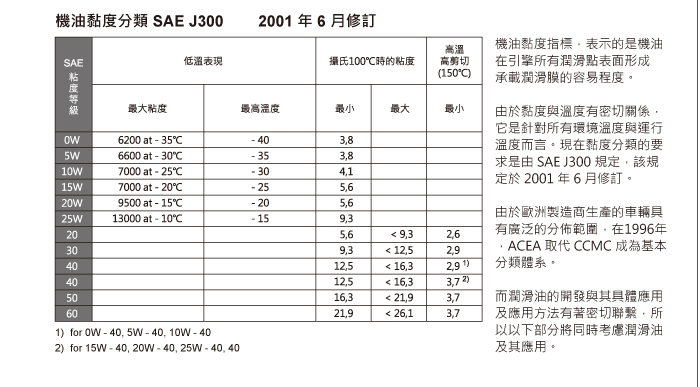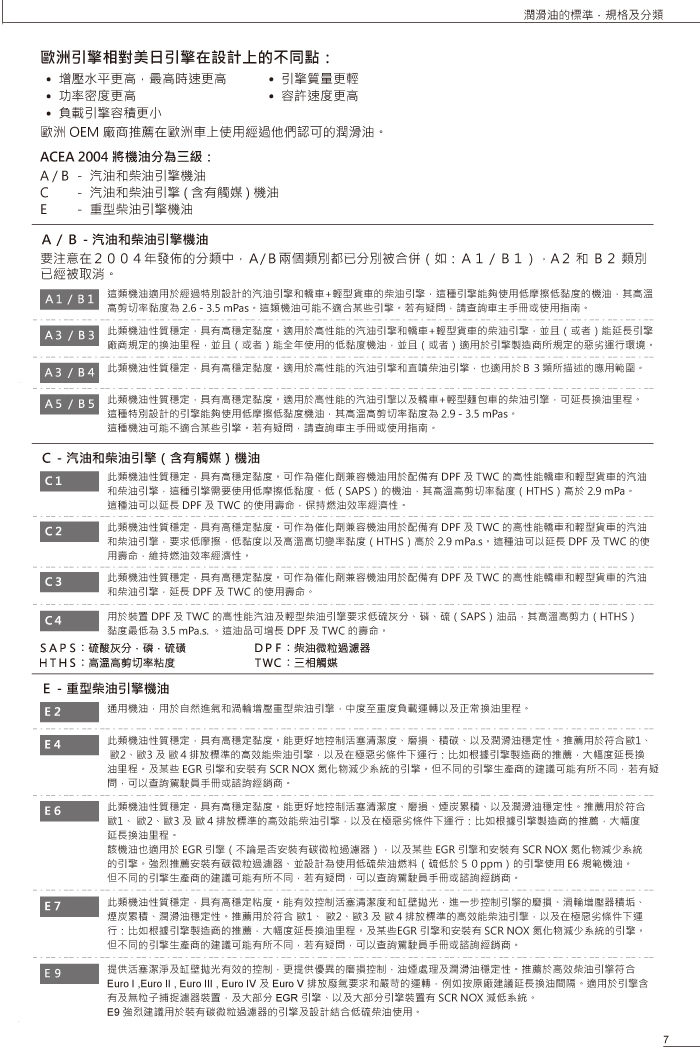
The primary maintenance for automobile - correct engine oil replacement
Oil Specification
Engine lubricant, is responsible for lubricating internal parts of automobile, and its main function is to provide lubrication of the engine's operation. The metal surface protective film can protect it without friction, also can absorb engine heat to reach the cooling effect. Therefore changing oil regularly is the primary maintenance work for automobile.
The general level of oil product usually have two kinds: API and SAE. API represents abbreviation of the American Petroleum Institute, and this Institute is responsible for oil quality level testing and certificating. It shows a clear demarcation between product differences in classification. The prefix "S" is refer to gasoline engines, in addition to the prefix "C" is for diesel engines. In addition to choosing product by the prefix, the rear needs to be concerned. It represents the level of quality identification, such as four-stroke engine oil for SA → SB → SC → SD → SE → SF → SG → SH → SJ → SL → SM → SN, these levels are actually required demands of environmental protection and lubrication. It contains different formulated additives. 1950s SA ~ SD rating currently is not used for the market. The SN category is the latest standards issued on October 2010. For diesel engine oil: CD → CE → CG → CI. CA and CB is currently not used anymore, while the current market could see a diesel car required low sulfur content recommended by CI level to reduce carbon deposits inside the engine and extend the duration of DPF usage.

For SAE, it is an acronym for the American Association of Engineers of the vehicle, this Association is responsible for confirming correct designation for oil viscosity. What is designation? On behalf of the oil viscosity index specifications, when the oil certified, consumers can purchase according to the number of oil designation. Usually they indicate information such as: 5W / 50. For the front figure, it means winter degree, representing the low viscosity values used to determine the degree of difficulty and low start-up flow efficiency, such as the common 0W, 10W, 15W, 20W, etc., in addition to the rear of the value is used to determine the toughness at high ambient temperatures, such as SAE 20,30,30,50 or 60. The lowest viscosity, of course presents greater scope of the wide temperature, but with a growing oil technology the more sophisticated and leap, designation identification engine processing technology is also worth thinking to users.
In addition to the American Association of API, the European Automobile Manufacturers Association, ACEA, also makes a classification for the quality of gasoline and diesel engine oil, "A" represents the beginning of the specification for gasoline engines, currently divided into A1, A2, A3, A4 and A5 grade five. Starting from "B" indicates light-duty diesel engines, grade section B1 to B5 are currently five specifications. The beginning of "E" is set in heavy duty diesel engine oil, currently divided into E2, E3, E4, E5, E6 and E7 six grades. Comparing to classification standard of API, ACEA’s standard is more delicate. Another response to facilitate industrial use, each sequence of two numbers plus the classification were the performing year (such as A3 rating -98 Year).

Differences between "synthetic" and "mineral oil"
"Mineral oil":
To use the proceeds of crude oil fractionation cracking mineral base oil, and adding a variety of additives. The main ingredients of hydrocarbons, chemical molecular structure of the mineral oil is more fragile, and its low temperature fluidity, high temperature oxidation resistance, viscosity index volatility and other characteristics are somewhat less than the synthetic, but still enough to competent general driving conditions.
"Semi-synthetic":
Certain proportion added into prepared base oils, whcih are mineral oils and synthetic oils, made from a variety of additives. Such oil has superior chemical stability of mineral oil molecules, will feature two different base oils and have more practical benefits.
"Full synthetic oil":
The use of synthetic esters or synthetic hydrocarbon with chemical reaction for the production of base oil, adding a variety of additives made of the same. Providing antioxidant, excellent low temperature fluidity, high viscosity index, low volatility, and high temperature stability and other characteristics. Even under intensive driving condition or after long time driving at high engine loads, still able to achieve best performance.

Engine oil selection techniques: huge difference between new car and old car
For choosing lubricants, SAE viscosity index and oil quality these two aspects are important. First, for oil quality, a mineral oil belongs to middle level of products. The price is cheaper, suitable for general driving condition and for more conservative maintenance budget. Semi-synthetic oil is a balanced product, regardless of performance and price are more moderate, it is a mainstream products on the market. And fully synthetic oil is suitable for intensive driving condition, such as burden supercharged engine vehicles.
The viscosity index will be a lot more complicated than oil quality. Only for the viscosity index, the market will have more than ten variety. Customers should pay attention to the choice of their own needs. For a new car, the run-in period is best to use a good cleaning power. The viscosity is not that important because new car’s piston and cylinder gap is small, the more dilute oil with easy access is helpful to the gap. The run-in here is to remove possible impurities inside the engine, so shorten oil change frequency is required. Besides to automobile manufacturer’s proposal in 1000, 5000 km maintenance, additional 3000 km is also the best time to change oil. It’s good for future engine life and performance. As the end of general run-in period, the not-too old vehicle, you can choose depending on driving habits, low viscosity oil for the speed of the rising rate has a positive benefit, but less durable, require more frequent replacement, and high viscosity oil, even after intense exercise drive, hydraulic still maintain a certain level, when three one thousand km oil change and remove the oil still has a certain viscosity.
To older vehicles, the relatively high viscosity of the oil should be used, due to internal engine parts will have some loss of long-term use, the use of high viscosity oil, and mechanical damage can effectively fill part. By avoiding damage to parts of the sustained expand, if necessary, to consider while adding a protective effect of oil additives to extend engine life. In terms of 5W / 40 and 10W / 60 oil both to the different viscosity than the right, the latter whether in low or high temperatures have a high viscosity, low temperature start-up. If the viscosity is too high, the fluidity is relatively poor, will be able to cause engine wear. On the contrary at high temperatures, adequate viscosity represents tough film, can provide better protection when the engine intense exercise. In short, the former corresponds to a cold start, the lower the operating temperature of the engine case, the latter when the protective effect is still to perform high-speed, high load.






